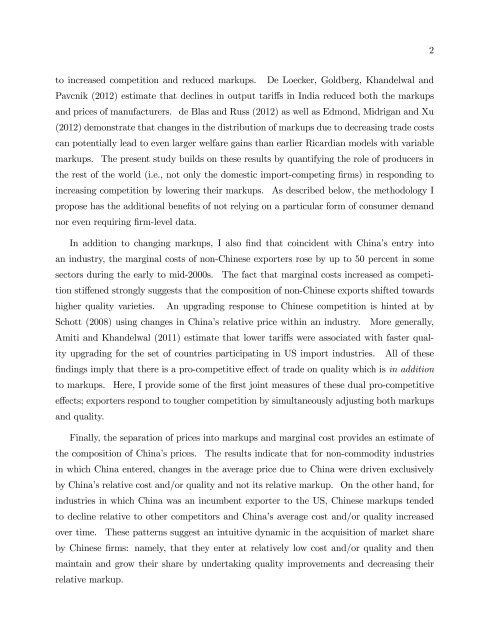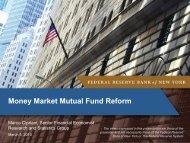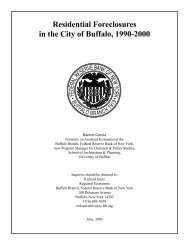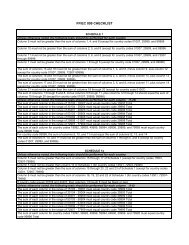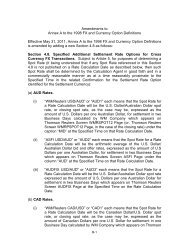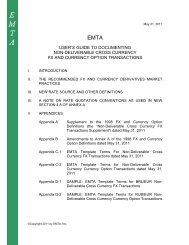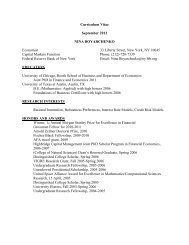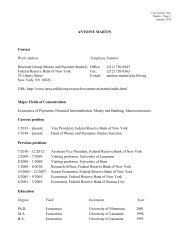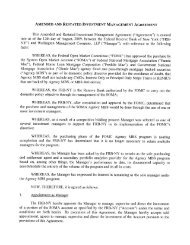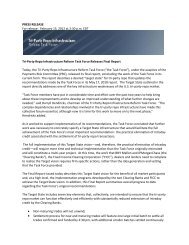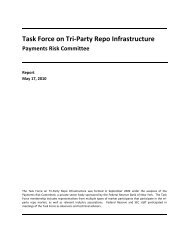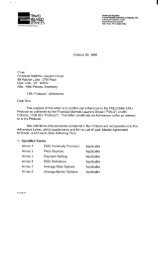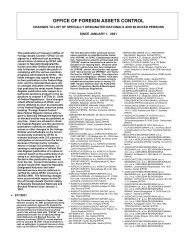Chinese Exports and U.S. Import Prices - Federal Reserve Bank of ...
Chinese Exports and U.S. Import Prices - Federal Reserve Bank of ...
Chinese Exports and U.S. Import Prices - Federal Reserve Bank of ...
Create successful ePaper yourself
Turn your PDF publications into a flip-book with our unique Google optimized e-Paper software.
to increased competition <strong>and</strong> reduced markups. De Loecker, Goldberg, Kh<strong>and</strong>elwal <strong>and</strong><br />
Pavcnik (2012) estimate that declines in output tari¤s in India reduced both the markups<br />
<strong>and</strong> prices <strong>of</strong> manufacturers. de Blas <strong>and</strong> Russ (2012) as well as Edmond, Midrigan <strong>and</strong> Xu<br />
(2012) demonstrate that changes in the distribution <strong>of</strong> markups due to decreasing trade costs<br />
can potentially lead to even larger welfare gains than earlier Ricardian models with variable<br />
markups. The present study builds on these results by quantifying the role <strong>of</strong> producers in<br />
the rest <strong>of</strong> the world (i.e., not only the domestic import-competing …rms) in responding to<br />
increasing competition by lowering their markups. As described below, the methodology I<br />
propose has the additional bene…ts <strong>of</strong> not relying on a particular form <strong>of</strong> consumer dem<strong>and</strong><br />
nor even requiring …rm-level data.<br />
In addition to changing markups, I also …nd that coincident with China’s entry into<br />
an industry, the marginal costs <strong>of</strong> non-<strong>Chinese</strong> exporters rose by up to 50 percent in some<br />
sectors during the early to mid-2000s. The fact that marginal costs increased as competi-<br />
tion sti¤ened strongly suggests that the composition <strong>of</strong> non-<strong>Chinese</strong> exports shifted towards<br />
higher quality varieties. An upgrading response to <strong>Chinese</strong> competition is hinted at by<br />
Schott (2008) using changes in China’s relative price within an industry. More generally,<br />
Amiti <strong>and</strong> Kh<strong>and</strong>elwal (2011) estimate that lower tari¤s were associated with faster qual-<br />
ity upgrading for the set <strong>of</strong> countries participating in US import industries. All <strong>of</strong> these<br />
…ndings imply that there is a pro-competitive e¤ect <strong>of</strong> trade on quality which is in addition<br />
to markups. Here, I provide some <strong>of</strong> the …rst joint measures <strong>of</strong> these dual pro-competitive<br />
e¤ects; exporters respond to tougher competition by simultaneously adjusting both markups<br />
<strong>and</strong> quality.<br />
Finally, the separation <strong>of</strong> prices into markups <strong>and</strong> marginal cost provides an estimate <strong>of</strong><br />
the composition <strong>of</strong> China’s prices. The results indicate that for non-commodity industries<br />
in which China entered, changes in the average price due to China were driven exclusively<br />
by China’s relative cost <strong>and</strong>/or quality <strong>and</strong> not its relative markup. On the other h<strong>and</strong>, for<br />
industries in which China was an incumbent exporter to the US, <strong>Chinese</strong> markups tended<br />
to decline relative to other competitors <strong>and</strong> China’s average cost <strong>and</strong>/or quality increased<br />
over time. These patterns suggest an intuitive dynamic in the acquisition <strong>of</strong> market share<br />
by <strong>Chinese</strong> …rms: namely, that they enter at relatively low cost <strong>and</strong>/or quality <strong>and</strong> then<br />
maintain <strong>and</strong> grow their share by undertaking quality improvements <strong>and</strong> decreasing their<br />
relative markup.<br />
2


